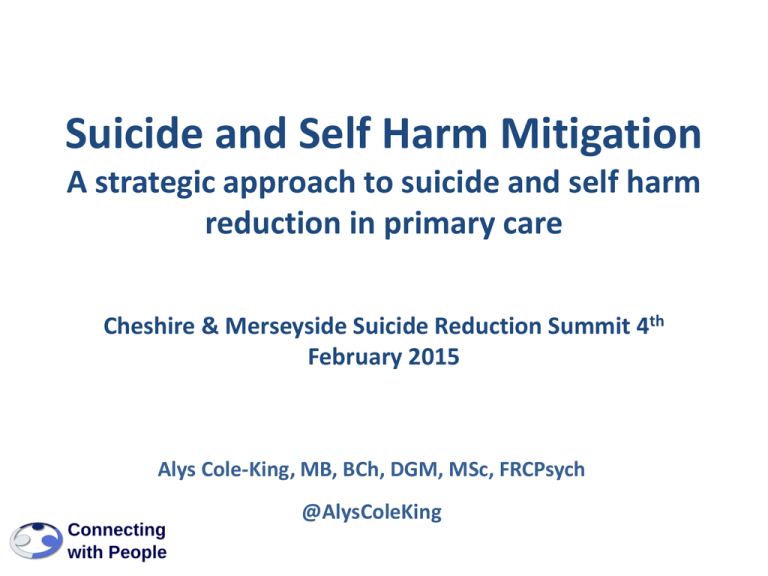Suicide Prevention in Primary Care: Combining Clinical
advertisement

Suicide and Self Harm Mitigation A strategic approach to suicide and self harm reduction in primary care Cheshire & Merseyside Suicide Reduction Summit 4th February 2015 Alys Cole-King, MB, BCh, DGM, MSc, FRCPsych @AlysColeKing Mental illness 1 in 3 Suicidal thoughts 1 in 5 5 5 Identification of suicide risk Patients identified as high risk Surface Level Patients identified as low risk Strategic priorities in suicide prevention Clinical GOVERNANCE Practitioners have the right SKILLS The people they approach show COMPASSION Suicidal People are AWARE they need help Key elements of suicide prevention Compassion Eradicate Stigma Awareness Knowledge Skills Common launguage Minimise Human Factors Errors Self-care Resilience & help seeking Suicide Prevention Changing working practices in primary care Compassion Reduce Stigma Bite Sized Training Consistent Assessment Framework/ Language Self Help Resources Wellbeing & Resilience Safety Plans Enhancing response primary care Awareness, Knowledge & skills in Assessing & recording Safely & efficiently triage Co-create safety plan Removal means Third sector Safely & efficiently refer to specialist services Clinical governance Common language Suicide Prevention Training Programmes Specialist MH Services Emergency Department GP with special interest General Hospital staff Rural primary care services Secondary Care Primary Care & Third Sector Healthcare Services Non-clinical NHS and Social Care Staff, Frontline staff, General Public GP & primary care teams Counselling services Allied health Profs Pharmacy Solutions • • • • • • • • Engage with GPs to increase training uptake RCGP Curriculum CPD sessions RCGP Mental Health Training Advisory Group Equal status given to suicide prevention training as CPR Needs to contribute to reduced HFE Needs to contribute to robust clinical governance Appraisal & revalidation • RCGP signed up to the Crisis Concordat Self-help leaflets U Can Cope Feeling on the edge helping you get through it Feeling overwhelmed and staying safe www.connectingwithpeople.org/ References: • • • • • • • • • Cole-King A, Green G, Gask L, Platt S (2013) Suicide Prevention are we doing enough? Advances in Psychiatric Treatment. 19:284-291 Cole-King A, Garett V, Williams H, Hines K, Platt S (2013) Suicide mitigation embedding compassion in clinical care. Advances in Psychiatric Treatment. 19:276283 Hines K, Cole-King A (2013) ‘Hey Kid are you OK..a story of a suicide attempt’ Advances in Psychiatric Treatment. 19:292-294 Cole-King A, Lepping, P Suicide mitigation: time for a more realistic approach. 2010. BJGP 3-4 Cole-King A, Lepping P (2010) Personal view: Will the new Government change our approach to risk? British Medical Journal, July. 341: c3890. Cole-King A, Green G, Peake-Jones G, Gask L (2011) The Assessment and Management of Patients with Suicidal Thoughts in Primary Care: An introduction to the concept and practicalities of suicide mitigation. Innovaite Vol 4: issue 5, 288-295 Cole-King A, Green G, Wadman S, Peake-Jones G, Gask L (2011)Therapeutic assessment of patients following self harm in primary care. Innovaite Vol 4: issue 5, p278 -287 Cole-King A (2010) Suicide Awareness in Primary Care: How making the right connections can save lives. RCGP News p 6. 2009 4 RCPsych peer reviewed poster presentations of all clinical tools Classification of suicidal thoughts (Cole-King 2010) • Passive • Active • Dangerous • Dangerous and imminent











